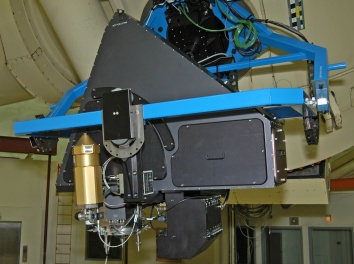First Light for VIRUS-W Spectrograph
25 January 2011
The new observing instrument VIRUS-W, built by the Max Planck Institute for
Extraterrestrial Physics and the University Observatory Munich, saw “first light”
November 10 on McDonald Observatory's 2.7-meter Harlan J. Smith Telescope in
West Texas. Its first images of a spiral galaxy about 30 million light-years away were
an impressive confirmation of the capabilities of the instrument, which can
determine the motion of stars in nearby galaxies to a precision of a few kilometers
per second.
"When we attached VIRUS-W around midnight on the 10th of November to the 2.7-meter telescope, we were very happy to see that the data delivered by VIRUS-W was of science quality virtually from the first moment on," said Maximilian Fabricius of the Max Planck Institute for Extraterrestrial Physics.
"As the first galaxy to observe we had selected the strongly barred galaxy NGC2903
at a distance of about 30 million light-years — right in front of our doorstep. The
data we collected reveal a centrally increasing velocity dispersion from about 80
km/s to 120 km/s within the field of view of the instrument. This was a very
exciting moment and only possible because of the remarkable teamwork during the
commissioning with a lot of support by the observatory staff!"
As an integral field spectrograph, VIRUS-W can simultaneously produce 267
individual spectra — one for each of its glass fibers. By dispersing the light into its
constituent colors, astronomers thus are able to study properties such as the
velocity distribution of the stars in a galaxy. For this they use the so-called Doppler
shift, which means that the light from stars moving toward or away from us is
shifted to blue or red wavelengths, respectively. This effect can also be observed on
Earth, when a fast vehicle, such as a racing car, is driving past: The sound of the
approaching car is higher, while for the departing car it is lower.
VIRUS-W´s unique feature is the combination of a large field of view (about 1x2
arcminutes) with a relatively high spectral resolution. With the large field of view,
astronomers can study nearby galaxies in just one or a few pointings, while the high
spectral resolution permits a very accurate determination of the velocity dispersion
in these objects. In this way, astronomers obtain the large-scale kinematic structure of nearby spiral galaxies, which will give important insight into their formation history.
Most galaxies are too distant, and the separation between their billions upon billions
of stars too small, to resolve with even the best, cutting-edge instruments.
Astronomers therefore cannot study individual stars in these distant galaxies, but
only the average motion along a specific line of sight.
The measured velocity distributions are characterised by two parameters: The
mean velocity reveals the large-scale motion of the stars along the line of sight. The
velocity dispersion measures how much the velocities of the individual stars differ
from this mean velocity. If the stars have more or less the same velocity, the
dispersion is small, if they have very different velocities, the dispersion is broad. For
spiral galaxies, where the stars travel in fairly regular circular orbits, the velocity
dispersion is mostly small. In elliptical galaxies, however, the stars have rather
disordered orbits and so the dispersion is broad.
With the high spectral resolution of VIRUS-W, astronomers can investigate
relatively small velocity dispersions, down to about 20 km/s. This was impressively
confirmed by the first images taken by VIRUS-W of the nearby spiral galaxy NGC
2903 (see image link at end).
The observing time at the telescope was made available by the VENGA project, to
which VIRUS-W will be contributing from the beginning of 2011 onward. VENGA, the VIRUS-P Exploration of Nearby Galaxies project, is a detailed spectroscopic study of 30 nearby spiral galaxies. The project is run by University of Texas at Austin graduate student Guillermo Blanc.
The VIRUS-P instrument, on which VIRUS-W is based, has probed these 30 galaxies
in a wide range of wavelengths, from ultraviolet light all the way into the red portion
of the visible spectrum. This wide wavelength range allows astronomers to probe a
large number of questions about these galaxies, from their star formation rate to
their ages.
"VIRUS-W is an improved version of VIRUS-P," Blanc said. Astronomers will follow
up the VIRUS-P studies by using VIRUS-W to look into the hearts of the brightest
spiral galaxies in the sample to get what Blanc calls "exquisite measurements" of the motions of stars and gas clouds inside these galaxies. Understanding how stars and gas move will help astronomers better understand how stars form.
VIRUS-P is a prototype of the VIRUS spectrograph being developed for the HETDEX
project led by The University of Texas at Austin. For a study of the large scale
distribution of galaxies, HETDEX will combine about 100 spectrographs at the 9.2-
meter Hobby-Eberly Telescope at McDonald Observatory to form one large
instrument. VIRUS-W (where the W stands for a later mission at the Wendelstein
telescope of the Munich Observatory) is based on the same basic VIRUS design.
— END —
Media Contacts
Rebecca Johnson
McDonald Observatory/University of Texas at Austin
512-475-6763
Dr. Hannelore Hämmerle
Max Planck Institute for Extraterrestrial Physics
+49 89 30000-3980
Science Contacts
Guillermo Blanc
University of Texas at Austin
512-471-1495
Maximilian Fabricius
Max Planck Institute for Extraterrestrial Physics, Garching
+49 89 30000-3694
Prof. Dr. Ralf Bender, Dr. Frank Grupp
Max Planck Institute for Extraterrestrial Physics, Garching
University Observatory Munich
Dr. Niv Drory, Dr. Robert Saglia
Max Planck Institute for Extraterrestrial Physics, Garching







